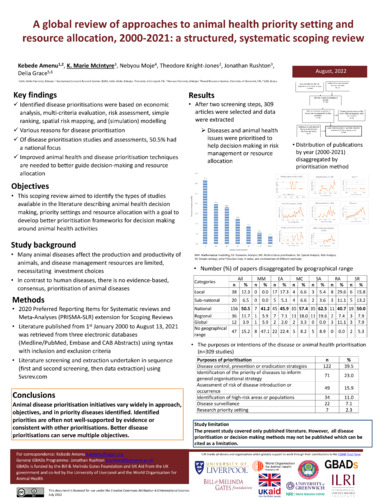A global review of approaches to animal health priority setting and resource allocation, 2000 -2021: A structured, systematic scoping review
Abstract
Objective
The objective of this scoping review was to identify and describe methods that have been used to
prioritise animal diseases to allocate resources for interventions associated with disease control,
surveillance or research.
Materials and methods
Three electronic databases (Medline/PubMed, Embase and CAB Abstracts) were searched using
syntax with inclusion and exclusion criteria. The search identified 6395 articles after de-duplication.
Upon manual searching, an additional 64 articles were added. A total of 6460 articles were finally
imported to an online systematic review management software (sysrev.com) for screening. Based
on inclusion and exclusion criteria, 532 articles passed the first screening and after the second
round of screening, 336 were recommended for a full review.
Results
The main methods of disease prioritisation identified were based on economic analysis, multi-criteria
evaluation, risk assessment (qualitative, quantitative or semi-quantitative), simple ranking, spatial
risk mapping and simulation modelling. Disease prioritisation was performed for the following
reasons: 1) disease control, prevention or eradication strategies, 2) identification priority of diseases
to inform general organisational strategy, 3) identification of high-risk areas or populations, 4)
assessment of the risk of disease introduction or occurrence, 5) disease surveillance and 6)
research priority setting. With regard to the geographical focus of the 336 articles prioritisation
studies and assessments screened 49% had a national focus, 13% were local, 12% were regional,
7% were sub-national and 4% were global; 16% had no particular geographic focus.
Conclusion
This review describes the different approaches available for prioritising animal health investments
and reflects on the pros and cons of different approaches. It also considers approaches used in
other fields such as environment and human health and reflects on their suitability for animal health
decision making.

